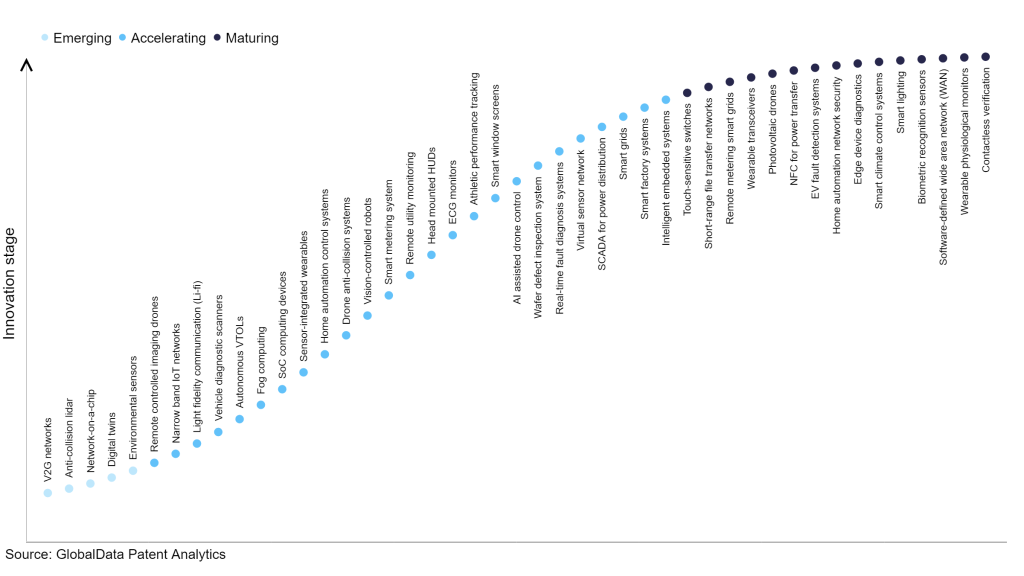The technology industry continues to be a hotbed of innovation, with activity driven by widespread adoption of Internet of Things (IoT) devices, increasing focus on personal health monitoring, the rise of chronic diseases, and the growing adoption of fitness and wellness tracking, and growing importance of technologies such as wearable physiological monitors including sensor technology, wireless connectivity, data analytics, and mobile applications. In the last three years alone, there have been over 3.6 million patents filed and granted in the technology industry, according to GlobalData’s report on Innovation in Internet of Things: Wearable physiological monitors. Buy the report here.
However, not all innovations are equal and nor do they follow a constant upward trend. Instead, their evolution takes the form of an S-shaped curve that reflects their typical lifecycle from early emergence to accelerating adoption, before finally stabilising and reaching maturity.
Identifying where a particular innovation is on this journey, especially those that are in the emerging and accelerating stages, is essential for understanding their current level of adoption and the likely future trajectory and impact they will have.
300+ innovations will shape the technology industry
According to GlobalData’s Technology Foresights, which plots the S-curve for the technology industry using innovation intensity models built on over 2.5 million patents, there are 300+ innovation areas that will shape the future of the industry.
Within the emerging innovation stage, environmental sensors, digital twins, and network-on-a-chip are disruptive technologies that are in the early stages of application and should be tracked closely. Intelligent embedded systems, smart factory systems, and smart grids are some of the accelerating innovation areas, where adoption has been steadily increasing. Among maturing innovation areas are contactless verification, wearable physiological monitors, and software defined wide area network, which are now well established in the industry.
Innovation S-curve for IoT in the technology industry

Wearable physiological monitors is a key innovation area in IoT
Wearable physiological monitors are wearable devices that individuals wear on their bodies to measure and monitor vital signs, including heart rate, blood pressure, respiratory rate, body temperature, and other relevant metrics. These devices play a crucial role in health monitoring, diagnostics, and overall well-being assessment.
GlobalData’s analysis also uncovers the companies at the forefront of each innovation area and assesses the potential reach and impact of their patenting activity across different applications and geographies. According to GlobalData, there are 130+ companies, spanning technology vendors, established technology companies, and up-and-coming start-ups engaged in the development and application of wearable physiological monitors.
Key players in wearable physiological monitors – a disruptive innovation in the technology industry
‘Application diversity’ measures the number of different applications identified for each relevant patent and broadly splits companies into either ‘niche’ or ‘diversified’ innovators.
‘Geographic reach’ refers to the number of different countries each relevant patent is registered in and reflects the breadth of geographic application intended, ranging from ‘global’ to ‘local’.
Patent volumes related to wearable physiological monitors
Source: GlobalData Patent Analytics
Samsung Group is a leading patent filer in wearable physiological monitors. One of the company’s patents describes the electronic device with a processor that can receive a user's biological signal. It can determine if the device is attached or detached from the user based on the signal and can control the operation of an I/O device accordingly.
Other prominent patent filers in the space include NIKE and Apple.
By geographic reach, Omron Tateisi Electronics leads the pack, followed by Boeing and Sympara Medical. In terms of application diversity, Motorola Solutions holds the top position, followed by TritonWear and Innominds Software.
IoT innovation in wearable physiological monitors involves the development of wearable devices that can track and monitor various physiological parameters, such as heart rate, blood pressure, temperature, and activity levels. These devices are equipped with sensors and connected to the internet, allowing users to collect real-time data about their health and well-being. These innovations empower individuals to take charge of their health, enable remote patient monitoring, and support preventive healthcare measures.
To further understand how IoT is disrupting the technology industry, access GlobalData’s latest thematic research report on Internet of Things – Thematic Research.
Data Insights
From

The gold standard of business intelligence.
Blending expert knowledge with cutting-edge technology, GlobalData’s unrivalled proprietary data will enable you to decode what’s happening in your market. You can make better informed decisions and gain a future-proof advantage over your competitors.







